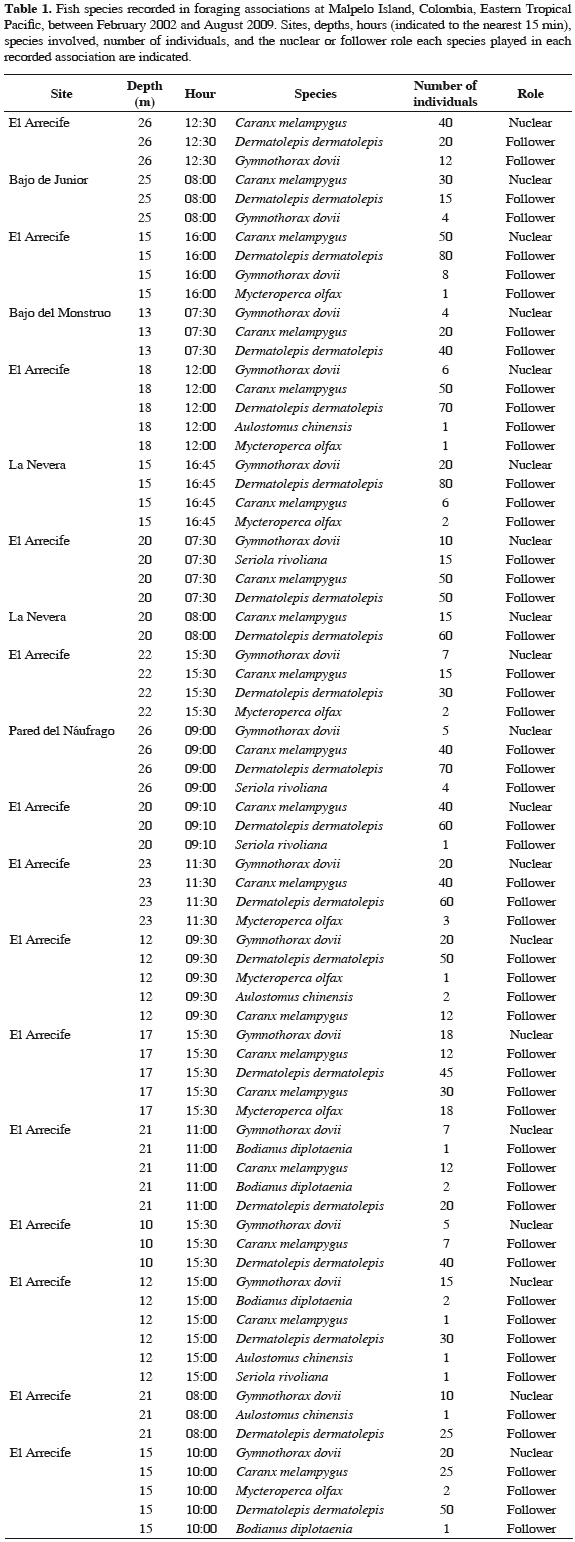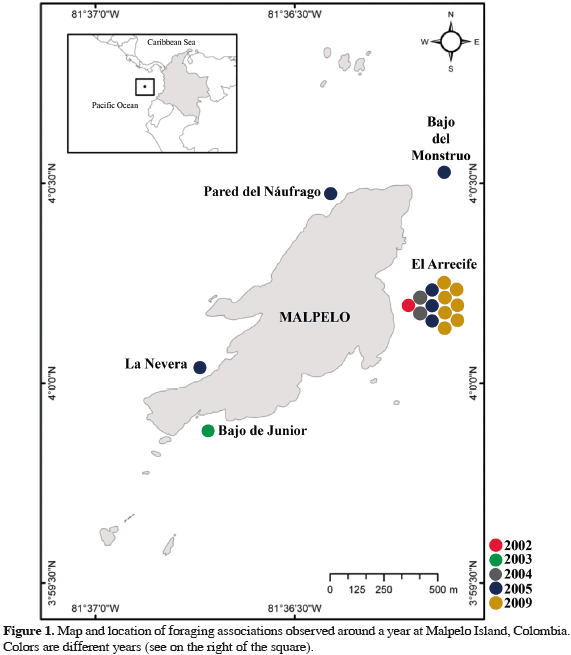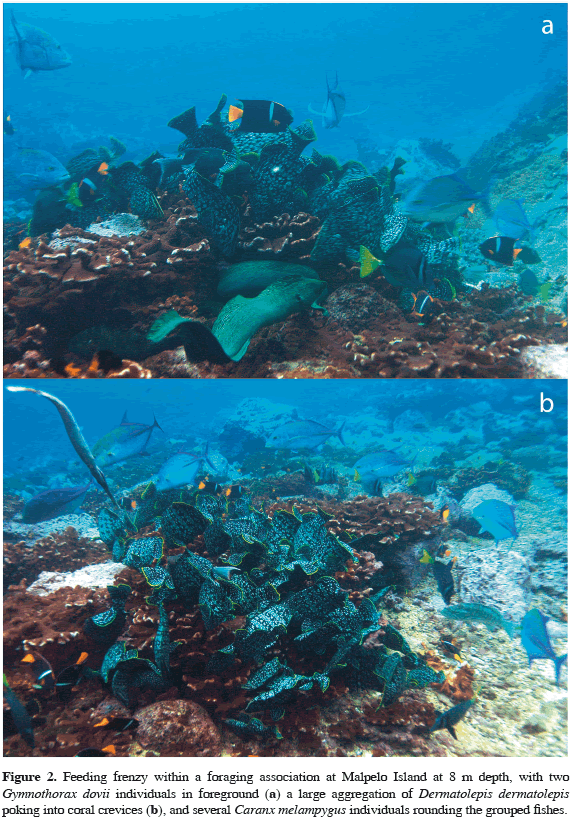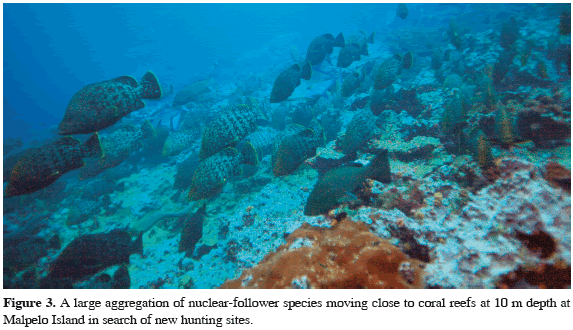Services on Demand
Journal
Article
Indicators
-
 Cited by SciELO
Cited by SciELO -
 Access statistics
Access statistics
Related links
-
 Cited by Google
Cited by Google -
 Similars in
SciELO
Similars in
SciELO -
 Similars in Google
Similars in Google
Share
Boletín de Investigaciones Marinas y Costeras - INVEMAR
Print version ISSN 0122-9761
Bol. Invest. Mar. Cost. vol.43 no.1 Santa Marta Jan./June 2014
NOTE:
REEF FISH FORAGING ASSOCIATIONS AT MALPELO ISLAND, COLOMBIA (TROPICAL EASTERN PACIFIC)
ASOCIACIONES ALIMENTARIAS EN PECES ARRECIFALES EN ISLA MALPELO, COLOMBIA (PACÍFICO ORIENTAL TROPICAL)
Juan P. Quimbayo1,2 Fernando A. Zapata2, Sergio R. Floeter1, Sandra Bessudo3 and Ivan Sazima4
1 Universidade Federal de Santa Catarina, Centro de Ciências Biológicas, Departamento de Ecologia e Zoologia, Lab. de Biogeografia e Macroecologia Marinha, Florianópolis, SC 88010-970, Brasil. jupaquia@gmail.com, sergio.floeter@ccb.ufsc.br.
2 Universidad del Valle, Departamento de Biología, Grupo de Investigación en Ecología de Arrecifes Coralinos, Cali, Colombia. Apartado aéreo 25360. fernando.zapata@correounivalle.edu.co.
3 Fundación Malpelo y Otros Ecosistemas Marinos, Carrera 11 No. 87-52 local 4, piso 2, Bogotá, Colombia. sbessudo@fundacionmalpelo.org.
4 Universidade Estadual de Campinas, Museu de Zoologia, Caixa Postal 6109, 13083-970 Campinas, São Paulo, Brasil. isazima@gmail.com.
RESUMEN
Varias especies de animales marinos establecen temporalmente asociaciones de caza interespecíficas, en las cuales especies oportunistas siguen a otras especies llamadas nucleares mientras estas buscan alimento pues disturban el substrato. Este tipo de comportamiento ha sido observado entre algunas especies de peces arrecifales en la isla Malpelo en el Pacífico colombiano. La morena Gymnothorax dovii y el jurel Caranx melampygus fueron identificados como especies nucleares mientras cazaban dentro del sitio conocido como El Arrecife. Estas especies fueron acompañadas por algunos meros Dermatolepis dermatolepis y Mycteroperca olfax, jurel Seriola rivoliana, pez corneta Aulostomus chinensis, la vieja Bodianus diplotaenia y en algunas ocasiones por el jurel Caranx melampygus, que tuvo ambos comportamientos (nuclear/seguidor). Este tipo de interacción alimentaria es un importante componente en la estructura trófica de las comunidades arrecifales que ocurren en todos los mares.
PALABRAS CLAVES: Asociación alimentaria, nucleares-seguidores, depredación, Colombia.
Several studies have reported temporary interspecific feeding associations between different species of reef fishes and, less often, other animals (e.g. Hobson, 1968; Lukoschek and McCormick, 2000; Sazima et al., 2007). These associations usually occur when food-seeking animals called "nuclear species" disturb the substrate, thus attracting opportunistic species or "followers" (Fricke, 1975; Fishelson, 1977; Krajewski, 2009). It has been suggested that followers are also attracted by particular characteristics of nuclear species such as body shape, size, color, and swimming behaviour (Fricke, 1975; Fishelson, 1977; Bshary et al., 2006; Araújo et al., 2009; Krajewski, 2009). The nuclear role is mostly played by fishes, and less often by octopuses, sea-stars, and turtles (Diamant and Shpigel, 1985; Gibran, 2002; Sazima et al., 2004; Pereira et al., 2011), while the follower role may be played by several opportunistic animals, mostly fishes (Bellwood et al., 2006).
Multi-species fish foraging associations range from simple to complex, and from highly transient to obligate associations (Sazima et al., 2007). They are formed by a wide range of fish species, from many families, and include most trophic groups (Lukoschek and McCormick, 2000; Pereira et al., 2012). Most nuclear reef fish species are active hunters (e.g. carnivores such as eels, groupers, or stingrays) and occasionally herbivores (such as acanthurids and labrids; Ormond, 1980; Lukoschek and McCormick, 2000; Sazima et al., 2005). Species considered as followers are carnivores (especially zoobenthivores) with opportunistic foraging behaviours, a common feature in reef fishes (Strand, 1988; Lukoschek and McCormick, 2000), which would explain the greater number of follower species compared to that of the nuclear ones (Gerking, 1994; Sazima et al., 2005; Bellwood et al., 2006).
These associations are facilitated by carnivorous fishes employing a variety of foraging tactics including disguise, ambush, stalking, and roving (Sazima, 1986; Gerking, 1994; Krajewski, 2009). Some species usually use one or two tactics, whereas others may employ several tactics according to circumstances (Hobson, 1968; Gerking, 1994). Due to the great behavioural plasticity found in reef fishes, many species could play both the nuclear and the follower role. For example, at a single location species of the Mullidae, Labridae, Lutjanidae, Serranidae, Balistidae, and Muraenidae can play both roles (Fricke, 1975; Ormond, 1980; Aronson and Sanderson, 1987; Strand, 1988; Sazima et al., 2007; Pereira et al., 2011).
Despite the nuclear-follower feeding interactions being a common interspecific interaction among reef fishes, little is known about the number of species and individuals that participate in a given feeding association event. Indeed, most studies focused on one or a few nuclear and/or follower species or even a particular kind of association (Ormond, 1980; Diamant and Shpigel, 1985; Strand, 1988; Baird, 1993; Auster and Lindholm, 2002; Gerhardinger et al., 2006; Félix and Hackradt, 2008).
We describe here an interspecific foraging association between several individuals of two nuclear species, the moray eel Gymnothorax dovii (Muraenidae) and the jack Caranx melampygus (Carangidae) with numerous individuals of several follower species: the groupers Dermatolepis dermatolepis and Mycteroperca olfax (Serranidae), the trumpetfish Aulostomus chinensis (Aulostomidae), the hogfish Bodianus diplotaenia (Labridae), and the jacks Seriola rivoliana and Caranx melampygus (Carangidae) (Table 1).
Observations were made at Malpelo Island (4°00'05"N, 81°36'30"W), a Sanctuary of Marine Fauna and Flora located 380 km off the coast of Colombia, in the Tropical Eastern Pacific (Birkeland et al., 1975; Zapata and Vargas-Ángel, 2003). The island is characterized by a rocky bottom and a relatively high cover of underdeveloped coral formations (Birkeland et al., 1975; Zapata and Vargas-Ángel, 2003). The nuclear-follower feeding interactions were recorded by scuba divers on 19 occasions between February 2002 and August 2009, and between 08:00-16:00 h at depths ranging from 8 to 27 m (Table 1). Nuclear-follower association was most commonly observed at a site known as El Arrecife (Figure 1). The interactions are described based on observations and photographs taken during fish visual censuses on the reef.
Feeding associations were initiated by the foraging activity of the moray eel Gymnothorax dovii (74% of the records) or the jack Caranx melampygus (26% of the records). The moray poked into coral branches (Pocillopora spp.) or entered within reef crevices in search of prey. This behaviour caused small fishes and invertebrates to flee and move out from their hiding places, thus attracting nearby carnivorous fishes such as groupers, jacks, and hogfish. These opportunistic predators fed frantically on the fishes and invertebrates as the latter fled from their hideouts (Figure 2). The grouper Dermatolepis dermatolepis took part as a follower in all recorded interactions, whereas the jack C. melampygus was the second most important follower, although sometimes it also played the role of nuclear species (Table 1). Caranx melampygus swam in groups and circled the reef portion that was under the moray's inspection, this behaviour possibly attracted other species such as groupers and trumpetfish.
The number of morays that took part in the interspecific foraging association varied (4-20), while the number of follower fishes was generally > 60 individuals, mostly groupers, jacks, trumpetfish, and hogfish, although there were instances that involved up to six different fish species (Table 1). The duration of a foraging bout at a single site varied from 3 to 5 min, after which the nuclear species would move, followed by the other predators until arriving at a new site where another feeding bout would begin (Figure 3). This process was repeated for an unknown, but presumably limited, number of times as the group of nuclear species and their followers moved along the reef.
This study stands out as the first record of a large feeding aggregation in the Eastern Tropical Pacific, as the association contained several individuals of two nuclear species and many individuals of at least four follower species. A nuclearfollower fish foraging association involving a moray eel and two species of groupers is known from the Gulf of California, but the recorded number of participants is only up to four individuals (Craig and Erisman, 2010). Other studies have described the behaviour of adult D. dermatolepis and Mycteroperca olfax as predominantly solitary, although they frequently occur in association with some labrid herbivores that facilitated these two groupers' preying on benthic fishes and crustaceans (Montgomery, 1975; Erisman et al., 2009). None of the two groupers have ever been recorded with other individuals of the same species, presumably due to competition for food (Filkovsky and Hoback, 2011). In contrast, at Malpelo Island several individuals of these two grouper species were involved in hunting during a feeding frenzy, which leads to the presumption that little competition occurs there (even if we have not quantitative data to support the assumption).
Interspecific associations in which great numbers of jacks and sea snakes aggregate in a feeding frenzy have been recorded ("Planet Earth: Shallow Seas"; BBC Natural History Unit, 2006). We suggest that sea snakes may be a functional counterpart of moray eels, as the snakes also are able to explore deep crevices otherwise inaccessible to predatory fishes.
Hypotheses about the benefits and costs of the nuclear-follower feeding associations vary. A general view is that the follower species benefit by enhancing prey detection and by gaining easier access to prey types that would otherwise be unavailable (Spotte, 1996; Lukoschek and McCormick, 2000; Sazima et al., 2007). Additionally, fishes involved in the association benefit from increased protection against predators (Roberts, 1996). From these two viewpoints, the nuclear-follower association could be described as an instance of commensalism, since the follower species benefits from the association while the nuclear species is not affected (Aronson and Sanderson, 1987; Lukoschek and McCormick, 2000. However, in some instances the nuclear species may be at a disadvantage due to competition for food, in which case the interaction could be described as a form of "parasitism" (Lukoschek and McCormick, 2000). The hypotheses are not mutually exclusive and, thus, more than one explanation applies to account for the benefits and/or disadvantages of different types of multispecies foraging associations (Krebs, 1973).
At Malpelo Island the great number of follower species (groupers, jacks, hogfish) and their surrounding the reef under inspection by the moray seem to benefit the nuclear species (moray eel) since they do not allow the small fish and invertebrates to flee into the water column. This particular feature may indicate a mutualistic interaction. A similar form of mutualism is reported for a moray eel and a grouper in the Red Sea (Bshary et al., 2006). In this latter case, however, there were fewer participants and the interaction and its duration depended on the hunger level of the groupers. At Malpelo Island, this association does not seem to strongly depend on the hunger level of the associated fishes, since the association was recorded at all times of the day. The large and multispecies association observed all day long in our study indicates that this type of interaction is very common there and can be an important component of the trophic structure of reef fish assemblages at Malpelo Island.
ACKNOWLEDGEMENTS
The research cruises carried out under the "Eastern Tropical Pacific Seascape" initiative. We thank Colombian National Natural Parks for permits, Conservation International, Unesco, The Walton Family Foundation and Fondo para la Acción Ambiental y la Niñez for the opportunity and funds for research at Malpelo's Sanctuary of Flora and Fauna. Ivan Sazima and Sergio Floeter thanks for the financial support from the CNPQ.
LITERATURE CITED
1 Araújo, M. E., P. H. C. Pereira, J. L. L. Feitosa, G. Gondolo, M. Nottingham and D. Pimenta. 2009. Feeding behavior and follower fishes of Myrichthys ocellatus (Anguilliformes: Ophichthidae) in the western Atlantic. Neotrop. Ichthyol., 7: 503-507. [ Links ]
2 Aronson, R. B. and S. L Sanderson. 1987. Benefits of heterospecific foraging by the Caribbean wrasse, Halichoeres garnoti (Pisces: Labridae). Env. Biol. Fishes, 18: 303-308. [ Links ]
3 Auster, P. J. and J. Lindholm. 2002. Pattern in the local diversity of coral reef fishes versus rates of social foraging. Caribb. J. Sci., 38: 263-266. [ Links ]
4 Baird, T. A. 1993. A new heterospecific foraging association between the pudding wife wrasse, Halichoeres radiatus, and the bar jack, Caranx ruber: evaluation of the foraging consequences. Env. Biol. Fishes, 38: 393-397. [ Links ]
5 Bellwood, D. R., P. C. Wainwright, C. J. Fulton and S. Hoey. 2006. Functional versatility supports coral reef biodiversity. Proc. Royal Soc., 273: 101-107. [ Links ]
6 Birkeland, C., D. L. Meyer, J. P. Stames and C. L. Buford. 1975. Subtidal communities of Malpelo Island. Smithson. Contrib. Zool., 176: 55-68. [ Links ]
7 Bshary, R., A. Hohner, K Ait-el-Djoudi and H. Fricke. 2006. Interspecific communicative and coordinated hunting between groupers and giant moray eels in the Red Sea. PLoSBiol., 4 (12): 2393-2398. [ Links ]
8 Craig, M. T. and B. E. Erisman. 2010. A competitive following association between two reef fishes and the jewelled moray in the Gulf of California Mexico. Coral Reefs, 29: 813. [ Links ]
9 Diamant, A. and M. Shpigel. 1985. Interspecific feeding association of groupers (Teleostei: Serranidae) with octopuses and moray eels in the Gulf of Eilat (Aqaba). Env. Biol. Fishes, 13: 153-159. [ Links ]
10 Erisman, B. E., T. H. Konotchick and S. Blum. 2009. Observations of spawning in the leather bass, Dermatolepis dermatolepis (Teleostei: Epinephelidae), at Cocos Island, Costa Rica. Env. Biol. Fishes, 85: 15-20. [ Links ]
11 Félix, F. C. and C. W. Hackradt. 2008. Interaction between Rachycentron canadum and Epinephelus itajara, on the Paraná Coast, Brasil. Coral Reefs, 27: 633. [ Links ]
12 Filkovsky, G. and W. W. Hoback. 2011. Effects of positional overlap on interactions and co-occurrence of follower fishes in benthic foraging associations. The Open Mar. Biol. J., 5: 68-72. [ Links ]
13 Fishelson, L. 1977. Sociobiology of feeding behavior of coral fish along the coral reef of the Gulf of Elat (Gulf of 'Aqaba), Red Sea. Israel J. Zool., 26: 114-134. [ Links ]
14 Fricke, H. W. 1975. The role of behaviour in marine symbiotic animals. 581-594. In: Jennings, D. H. and D. L. Lee (Eds.). Symbiosis, Symposia of the Society for Experimental Biology 29. Cambridge University Press, Cambridge. 633 p. [ Links ]
15 Gerhardinger, L. C., M. Hostim-Silva, R. Samagaia and J. P. Barreiros. 2006. A following association between juvenile Epinephelus marginatus (Serranidae) and Myrichthys ocellatus (Ophichthidae). Cybium, 30: 82-84. [ Links ]
16 Gerking, S. D. 1994. Feeding ecology of fish.Academic Press, San Diego, USA. 416 p. [ Links ]
17 Gibran, F. Z. 2002. The sea basses Diplectrum formosum and D. radiale (Serranidae) as followers of the sea star Luidia senegalensis (Asteroidea) in southeastern Brazil. Braz. J. Biol., 62: 591-594. [ Links ]
18 Hobson, E. S. 1968. Predatory behavior of some shore fishes in the Gulf of California. Fish. Bull., US Fish Wild Serv., 73: 1-92. [ Links ]
19 Krajewski, J. P. 2009. How do follower reef fishes find nuclear fishes? Env. Biol. Fishes, 86: 379-387. [ Links ]
20 Krebs, J. R. 1973. Social learning and the significance of mixed-species flocks of chickadees (Parus spp.). Can. J. Zool., 51: 1275-1288. [ Links ]
21 Lukoschek, V. and M. I. McCormick. 2000. A review of multi- species foraging associations in fishes and their ecological significance. Proc. 9th Internat. Coral Reef Symp., Bali, Indonesia, 1: 467-474. [ Links ]
22 Montgomery, W. L. 1975. Interspecific associations of sea basses (Serranidae) in the Gulf of California. Copeia, 4: 785-787. [ Links ]
23 Ormond, R. F. G. 1980. Aggressive mimicry and other interspecific feeding associations among Red Sea coral reef predators. J. Zool. (Lond.), 191: 247-262. [ Links ]
24 Pereira, P. H. C., R. L. G. Moraes, J. L. L. Feitosa and B. P. Ferreira. 2011. Following the leader: First record of a species from the genus Lutjanus acting as follower of an octopus. Mar. Bio. Rec., 4: e88. [ Links ]
25 Pereira, P. H. C., J. L. L. Feitosa, L. C. T. Chaves and M. E. Araújo. 2012. Reef fish foraging associations: "Nuclear-follower" behavior or an ephemeral interaction? Proc. 12th Internat. Coral Reef Symp., Cairns, Australia: 1-5. [ Links ]
26 Roberts, G. 1996. Why individual vigilance declines as group size increases. Anim. Behav., 51: 1077-1086. [ Links ]
27 Sazima, I. 1986. Similarities in feeding behaviour between some marine and freshwater fishes in two tropical communities. J. Fish Biol., 29 (1): 53-65. [ Links ]
28 Sazima, C., A. Grossman, C. Bellini and I. Sazima. 2004. The moving gardens: reef fishes grazing, cleaning, and following green turtles in SW Atlantic. Cybium, 28: 47-53. [ Links ]
29 Sazima, C., R. M. Bonaldo, J. P. Krajewski and I. Sazima. 2005. The Noronha wrasse: a jack-of-all-trades follower. Aqua. J. Ichthyol. Aq. Biol., 9: 97-108. [ Links ]
30 Sazima, C., J. P. Krajewski, R. M. Bonaldo and I. Sazima. 2007. Nuclear-follower foraging associations of reef fishes and other animals at an oceanic archipelago. Env. Biol. Fishes, 80: 351-361. [ Links ]
31 Spotte, S. 1996. Habitat and temporal effects on diurnal, mixed-species foraging associations of the yellow goatfish (Mulloidichthys martinicus) at Anse Chastanet, St. Lucia, West Indies. Caribb. J. Sci., 32: 21-25. [ Links ]
32 Strand, S. 1988. Following behavior: interspecific foraging associations among Gulf of California reef fishes. Copeia, 2: 351-357. [ Links ]
33 Zapata, F. A. and B. Vargas-Ángel. 2003. Corals and coral reefs of the Pacific coast of Colombia. 419-447. In: Cortés, J. (Ed.). Latin American coral reefs. Elsevier Science B.V., Amsterdam. 495 p. [ Links ]
FECHA DE RECEPCIÓN: 19/10/2012 FECHA DE ACEPTACIÓN: 19/02/2014

















